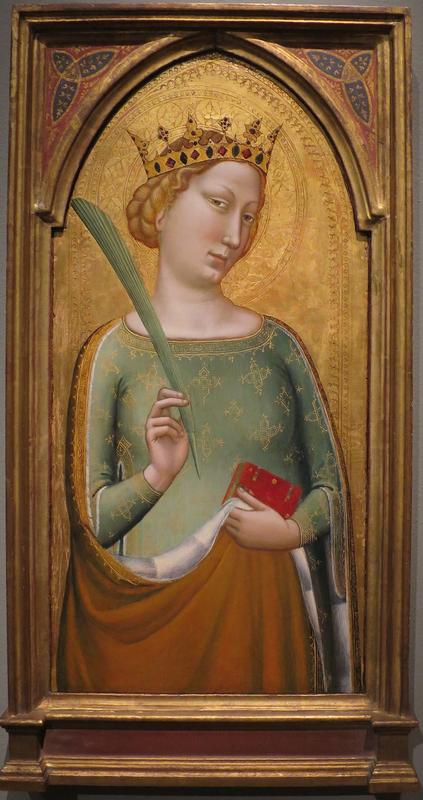More about A Crowned Virgin Martyr (Saint Catherine of Alexandria)

Contributor
The woman depicted here is St. Catherine of Alexandria, patron saint of mechanics, scholars, and wheelwrights. She was martyred in the year 305 for her beliefs and was badass enough to be immortalized as a religious icon for the faithful.
Born in 297, Catherine was of noble birth and had access to education in one of the most prosperous, educated cities of the age on par with Baghdad. By age 14, she chose to be baptized in the Christian faith.
When the emperor at the time, Maxentius, came knocking to hunt down the Christians in his realm, Catherine came to answer. At eighteen years old, the youth stood up to Maxentius, denouncing him for his cruelty and challenging his belief in the Roman pantheon. Astounded by her audacity and not willing to be humiliated by a teenage girl, he summoned fifty scholars in his defense to try to convince Catherine otherwise.
Before we continue, let’s clarify: this girl was very educated. So educated, in fact, that her oratory skills were enough to convince several of them to become Christians. Maxentius had those scholars executed and Catherine arrested. While imprisoned, over 200 people visited her cell, including the emperor’s own wife Valeria Maximillia. She too was convinced to go Christian. Maxentius eventually had her executed. With two defeats on his belt, the emperor tried to convince Catherine to marry him and become empress, and by extension, abandon her faith in favor of the polytheistic state religion. Best two out of three, Maxentius? Not this time. Catherine said no, and professed her love for Jesus Christ and her choice to stay virginal.
Salty at having been defeated three times in a row, the emperor ordered her personally executed on a breaking wheel. Here’s how it works: the person is strapped and threaded by their limbs to the spokes, upon which your friendly neighborhood executioner breaks the bones with a heavy rod. Only the worst of the worst would have this punishment, and Maxentius was feeling exceptionally petty. Here in Alexandria, however, breaking wheel doesn’t break Catherine. Rather, Catherine breaks breaking wheel. Without any other option left to him, Maxentius had her head lobbed off. Allegedly her body was picked up by angels and carried to Mt. Sinai, where a monastery dedicated to her stands to this day. The whole ordeal was so freakishly miraculous as to get her canonized and have the torture implement that was supposed to kill her renamed after her.
However, the entire account seems doubtful. In reality, Maxentius held no ill will toward Christians. He, in fact, was actually responsible for stopping their persecution, and most demonizations of him were done in favor of Constantine, who personally killed him in the midst of a huge succession dispute. The whole story regarding her execution may have been muddled with the accounts of other martyrs, and accounts of her did not surface until the 9th century
Nevertheless, she remains venerated to this day by both Orthodox and Catholic Christians for her faith and her steadfastness in the face of a spurned, salty emperor. While it would become common to depict her accompanied by either the wheel or the sword used to kill her as her attributes, here the richness of her dress and the martyr's palm she holds are clues that Catherine is the virgin Saint Daddi depicts. Two hundred years later, Raphael would also tribute a work to the saint. Smirk hard, Catherine. You’ve earned it, courtesy of Bernardo Daddi.
Sources
- Catholic Online. n.d. “St. Catherine of Alexandria - Saints & Angels.” Catholic Online. Catholic Online. Accessed November 25, 2018. https://www.catholic.org/saints/saint.php?saint_id=341.
- Hidalgo, Miguel. n.d. “St. Catherine of Alexandria.” CATHOLIC LIBRARY: Sublimus Dei (1537). Accessed November 25, 2018. http://www.newadvent.org/cathen/03445a.htm.
- “Maxentius.” 2018. Encyclopædia Britannica. Encyclopædia Britannica, inc. May 7, 2018. https://www.britannica.com/biography/Maxentius.
- “St. Catherine of Alexandria.” 2017. Encyclopædia Britannica. Encyclopædia Britannica, inc. March 28, 2017. https://www.britannica.com/biography/Saint-Catherine-of-Alexandria.











